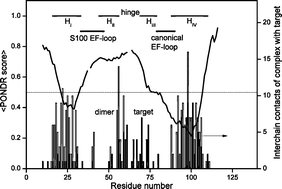Intrinsic disorder in S100 proteins†
Abstract
Although the members of the largest subfamily of the EF-hand

Maintenance work is planned from 09:00 BST to 12:00 BST on Saturday 28th September 2024.
During this time the performance of our website may be affected - searches may run slowly, some pages may be temporarily unavailable, and you may be unable to access content. If this happens, please try refreshing your web browser or try waiting two to three minutes before trying again.
We apologise for any inconvenience this might cause and thank you for your patience.
* Corresponding authors
a
Institute for Biological Instrumentation of the Russian Academy of Sciences, Institutskaya str., 7, Pushchino, Moscow region 142290, Russia
E-mail:
permyakov.s@gmail.com
Fax: +7 4967 33 05 22
Tel: +7 4967 73 58 63
b Department of Biomedical Engineering, Pushchino State University, Pushchino, Moscow region 142290, Russia
c
Department of Molecular Medicine, University of South Florida, 12901 Bruce B. Downs Blvd, MDC3540, Tampa, Florida 33612, USA
E-mail:
vuversky@health.usf.edu
Fax: +1-813-974-7357
Tel: +1-813-974-5816
d Center for Computational Biology and Bioinformatics, Department of Biochemistry and Molecular Biology, Indiana University School of Medicine, Indianapolis, USA
e Institute for Intrinsically Disordered Protein Research, Indiana University School of Medicine, Indianapolis, USA
f Department of Biosciences, Åbo Akademi University, Artillerigatan 6A, FI-20520 Turku, Finland
Although the members of the largest subfamily of the EF-hand

 Please wait while we load your content...
Something went wrong. Try again?
Please wait while we load your content...
Something went wrong. Try again?
S. E. Permyakov, R. G. Ismailov, B. Xue, A. I. Denesyuk, V. N. Uversky and E. A. Permyakov, Mol. BioSyst., 2011, 7, 2164 DOI: 10.1039/C0MB00305K
To request permission to reproduce material from this article, please go to the Copyright Clearance Center request page.
If you are an author contributing to an RSC publication, you do not need to request permission provided correct acknowledgement is given.
If you are the author of this article, you do not need to request permission to reproduce figures and diagrams provided correct acknowledgement is given. If you want to reproduce the whole article in a third-party publication (excluding your thesis/dissertation for which permission is not required) please go to the Copyright Clearance Center request page.
Read more about how to correctly acknowledge RSC content.
 Fetching data from CrossRef.
Fetching data from CrossRef.
This may take some time to load.
Loading related content
